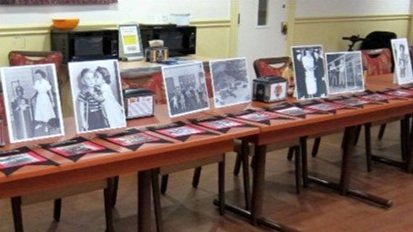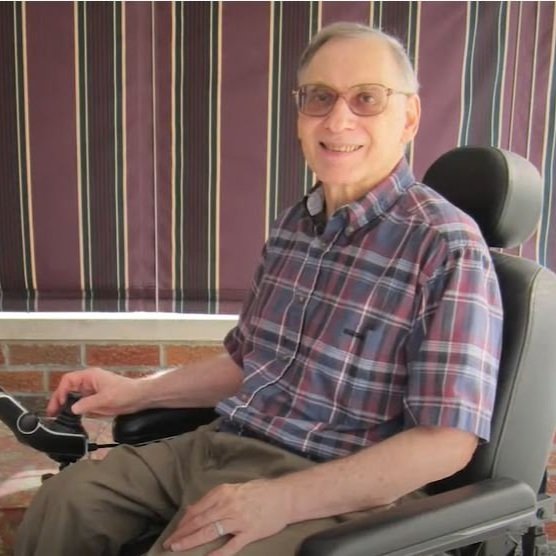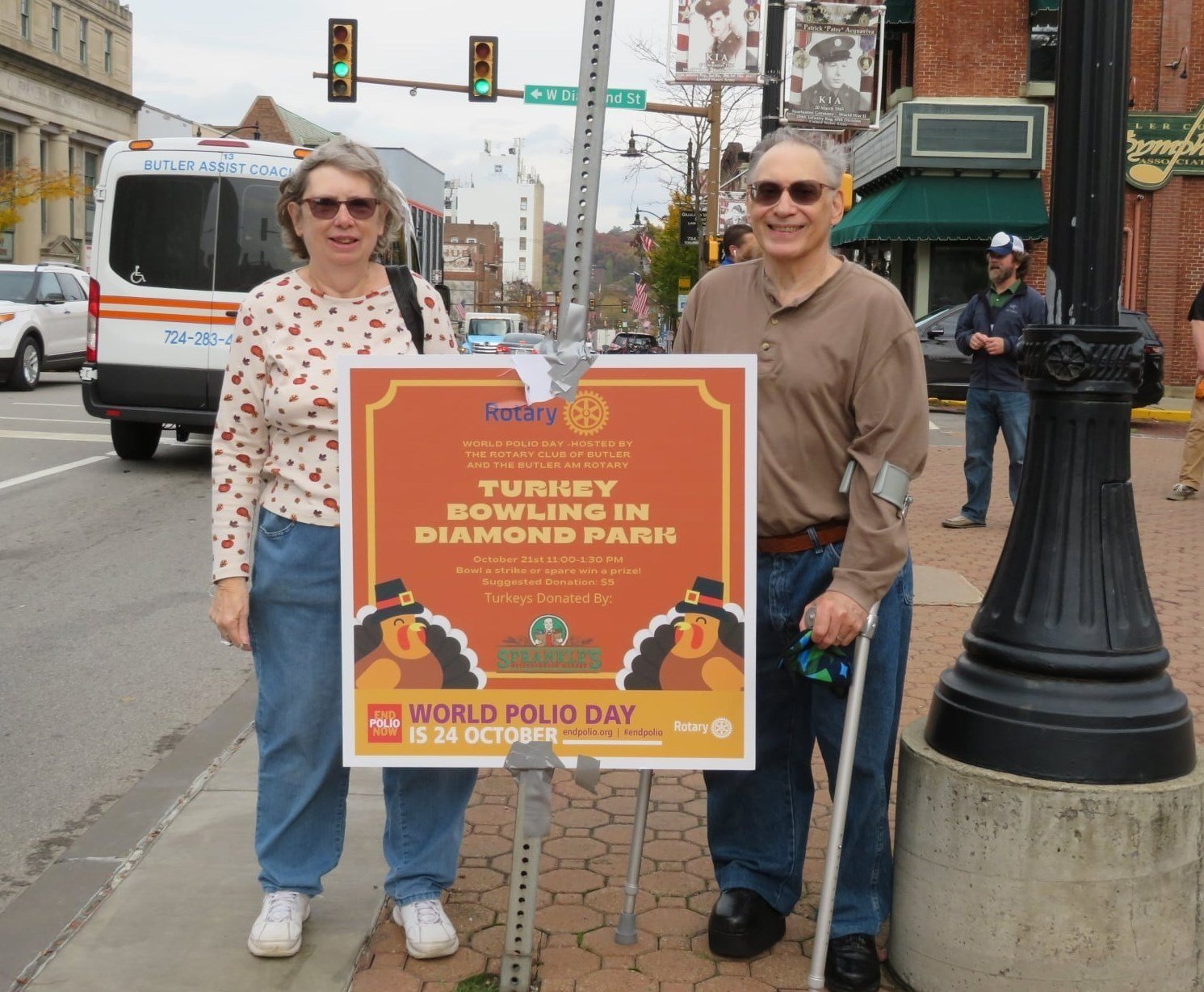My Polio Experience
By Joe Randig
My name is Joe Randig and I would like to tell you about my polio experience. It was the summer of 1952 and our country was in the middle of its worst polio epidemic since 1916. Nearly 58,000 cases of polio were reported and more than 3,000 died. I was lucky.
I started school in September and two weeks later I wasn’t feeling well. My mother said that I voluntarily came in from play to take a rest. She was concerned since this was not at all like me. The initial polio virus affects the nose, throat and sometimes the stomach followed by weakness and, if the virus enters the central nervous system, paralysis. My symptoms were fever, headache and stiff neck. I remember getting up during the night to use the bathroom and falling on my way back to bed. Those were the last steps I would ever take without the aid of braces and crutches.
Dr. John Burn diagnosed me with poliomyelitis on September 16. I have been told that he felt sure I had polio based on my symptoms and he had a spinal tap done at Butler County Memorial Hospital to confirm his feelings.
At the time, polio was thought to be very contagious and no one was sure how the virus was spread so the practice was to isolate the polio victim and quarantine the family. I was quickly transferred to Municipal Hospital in Pittsburgh where I remained in isolation for about one month. Also, everyone living in the same house with me was placed under quarantine for two weeks. This meant that notices were placed on the doors of the house and no one could leave or enter. Food and supplies were brought to the house by relatives who would set the items on the porch and step back from the house. Then someone would go out and retrieve the items. Can you imagine doing that today? Well, we did exactly that in 2021 when the Covid-19 pandemic spread around the world. Millions of people died and millions more became very sick. The world came to a stop for a few months, travel was restricted and many other restrictions were put in place. We were overwhelmed by the confusion of what it was, where it came from and how long was it going to last.
On October 25, I was admitted to the D. T. Watson Home For Crippled Children in Sewickley Pennsylvania, having been referred there by Dr. L. J. Grossman of Butler. The D. T. Watson Home became my home for the next 20 months.
Polio rehabilitation varied somewhat depending on the age of the patient, the extent and location of the paralysis, and what part of the country you happened to live in. The typical polio rehabilitation involved hot packs, (which consisted of very hot wool cloths that were wrapped around arms, legs, back or any affected area) muscle stretching and re-education via electrical stimulation, corrective surgery and aquatic exercise where it was available. The iron lung was necessary for those having bulbar polio which effected their ability to breathe. I don’t remember very much of my initial treatment but I have read that the hot packs and stretching were very painful.
After about five months of physical therapy I was fitted with full length leg braces on both legs and a back brace connected at the hips. With these and my crutches I was ready to walk again. Actually I needed to learn how to do everything over again. We even practiced crossing the street. There was a real traffic light on a hospital road but there was no intersection. The light would turn green and I’d start across. When I was about half way across the light would turn red. That wasn’t good enough, and this was only a single lane road.
I continued my first grade education while in the hospital. We had a classroom with a teacher and those who could, would spend some time there every day. For about for the first six months my family could visit on Sundays but I had very little contact with my brothers and sisters. I only went home for Thanksgiving and Christmas. Eventually I was able to go home on the weekends.
On June 26, 1954 I was discharged from the D. T. Watson Home. I remained under their care until 1960, periodically being admitted for check-ups, brace adjustments and repairs. All of my hospitalization, braces and crutches were paid for by the National Foundation for Infantile Paralysis better known as “The March of Dimes”.
About the time of my release from the hospital my family and I had the opportunity to be involved in the field testing of the Salk polio vaccine. The testing was conducted by Dr. Jonas Salk and the University of Pittsburgh School of Medicine. My Mother, Dad, brother, sisters and I were given injections of the vaccine. After a few months blood samples were taken. We would be given booster shots and they’d take more blood samples. The testing continued for a few years with our last blood samples being taken in 1961. (More about this in Joe’s story: Polo Pioneers - The Randig Family).
A highlight of my young life came in 1956 when I was honored by being chosen Butler County’s “Blue Crutch Boy” by the local chapter of the March of Dimes. As part of the promotion I was pictured twice in the “Butler Eagle” along with articles about my recovery and rehabilitation. The Blue Crutch pins were given out for donations to the March of Dimes fund-raising campaign.
As I reminisce about my polio experience a unique incident comes to mind. Around 1960 I was going to the Butler Memorial Hospital out-patient physical therapy department for some follow up therapy. My therapist, Al Peretic, gave me a leather wallet. Leather tooling was his hobby so he made a very nice hand-tooled wallet for me. He explained that my spine was starting to curve and suggested that I sit with the wallet under my right hip. This would help keep my spine straight while sitting. Gradually I regained enough strength to remove my back brace. After a few more years of rehabilitation, which included strength development of my upper body, I was able to go without my left leg brace.
Mr. Peretic was helpful to me in many ways. By now I was in my early teens and it had been a few years since I had had a good evaluation of my condition. Mr. Peretic told my parents about the Shriners’ hospitals and how they provide services free of charge for disabled children. Through sponsorship by two local Shriners, Judge Clyde Shumaker and Vernon Wise, Sr. I was admitted to Shriners’ Hospital in Philadelphia. I had a six month stay in Philadelphia for corrective surgery on both knees. I was fitted with new braces and shoes and released in time to start 9th grade.
While in my junior year of high school I met Fred Kinnick, the local counselor with the Bureau of Vocational Rehabilitation. Mr. Kinnick told me about the educational opportunities available through the B.V.R. I was tested, and based on my talents and interests I chose to attend the Ivy School of Professional Art. Over the next few years the B.V.R. also helped with my physical needs. This included new shoes and maintenance of my leg brace. After graduation I was hired by an advertising agency in Pittsburgh. The following year, I married my high school sweetheart, Linda.
I continued to work in Pittsburgh, but the commuting was starting to get to me so I decided to look for work in Butler. In September of 1969 I was hired by the Eagle Printery and worked there until I retired.
A lot has happened since I first compiled this information. I retired on disability in 2000 after 32 years of employment. Retirement has been great. It has been a big relief to get off my feet, relax and forget about the “9 to 5” demands. I continued to experience the late affects of polio to the point where it became more difficult to do the steps in my two story home. My shoulder problems continued, requiring rotator cuff surgery. Since I could not use my shoulder I had to spend six unpleasant weeks in a nursing home for rehabilitation. My home was not very accessible so it was time for some changes. We were making plans to add on a first floor bedroom and bathroom when we discovered that a ranch style house in our neighborhood was for sale. We purchased it in 2009 and proceeded with a major remodeling project to improve accessibility.
Aging with polio has continued to add to my ever present issues. My shoulder problems continue, I have had several Cortisone injections and physical therapy along with treatment from a massage therapist plus exercise, exercise, exercise. My weak and deformed feet are now supported by custom molded shoes. They are a great improvement over the old orthopedic shoes. I now have a stair lift, lift chair, platform lift and a scooter that I use when we go anywhere that requires a lot of walking. As I’ve aged, in addition to the pain and weakness that has come from the late effect of polio, I’ve had a TIA and hernia repair surgery. I ended 2014 with two new coronary stents and shoulder repair surgery.
Joe advocating for pediatric vaccination.
In 2016 I became the Western PA Coordinator for the PA Polio Survivors Network (www.polionetwork.org). I facilitated two conferences for survivors, have written many articles for newspapers advocating for pediatric vaccination, helped students on their National History Day competitions, and have been able to help bring information to survivors in Western PA. Through this advocacy work, I discovered that I get great satisfaction from having the opportunity to talk to and interact with other polio survivors as well as non survivors, who are seeking current and accurate information about post-polio syndrome.
I am 77 years old now and experiencing what I have been dreading, getting old with polio. In recent years I have had surgery on both shoulders and a few falls one requiring stitches in my head. My walking is more labored now and I don’t have the strength I had five years ago. I have had AFIB for the last few years. The doctors implanted a heart monitor and put me on two blood thinners.
My electric lift recliner, power wheelchair and the lift on the back of my car are now much needed equipment.
Thanks for reading “My Polio Experience”. I hope I was able to provide some insight into what it was like to have had polio in Butler, Pennsylvania and what it’s like to be experiencing post-polio syndrome more than 70 years later.
Originally published in 2015, this story was updated in 2024.











More from Joe and Linda Randig.
How I Got a New Sled and Almost Lost My Life !
Joe Randig: In Our Own Words (Video)
Loving Joe (by Linda Randig)
Perspectives on COVID-19 Vaccines for Kids: A Video for the Children's Hospital of Philadelphia
Polio and COVID-19: Then and Now
This story by the PA Immunization Coalition, includes three polio survivors – Joe Randig, Shirley Smith and Deborah Stambaugh






